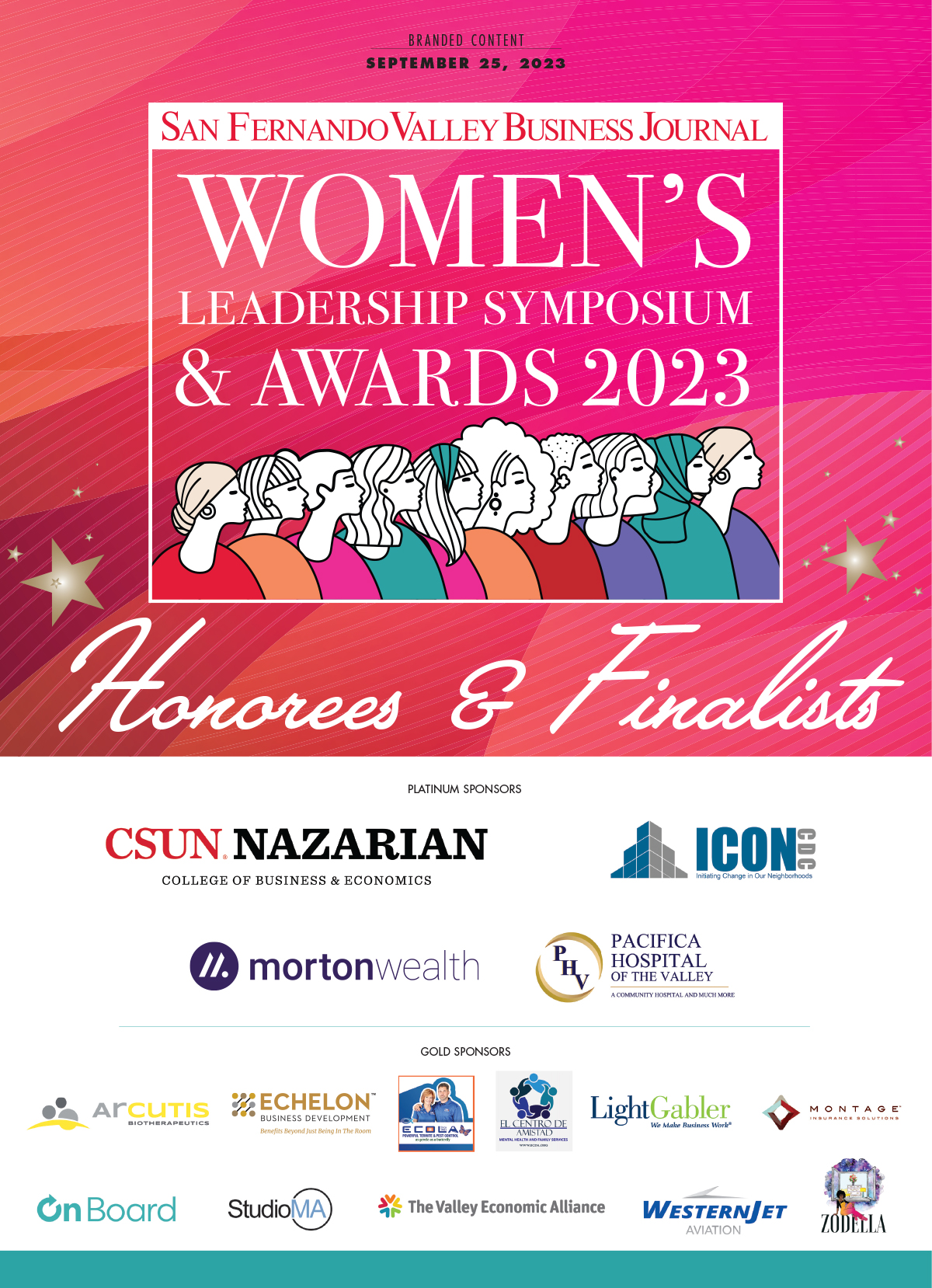
The Los Angeles Business Journal: Inside The Valley team was proud to celebrate many of the leading lights of business in the Valley for our Women’s Leadership Symposium & Awards event at the Warner Center Marriott in Woodland Hills on Thursday, September 5th. Once again this year, we brought the Valley’s Community of Business™ together, in person, for a half day of inspiration, education and recognition.
Our morning started with a series of speakers, discussing some of the most riveting and important issues impacting women with leadership roles in business today. Speakers included: Patrice Bening, wealth advisor, Morton Wealth; Dr. Amit Gosalia, board certified doctor of audiology, West Valley Hearing Center; Janice L. Miller, managing partner, Miller Haga Law Group; and Danone Simpson, CEO, Montage Insurance Solutions.
These inspiring talks were followed by a dynamic panel discussion that provided real-life examples and actionable takeaways on the topic of visionaries and leadership. Our insightful panelists included Chandra A. Beaton, Partner, LightGabler LLP; Tamara Gurney, President & CEO, Mission Valley Bank; Jerri Hemsworth, CEO & Creative Director, Newman Grace; Olga Kapitskaya, AVP – Financial Advisor, RBC Wealth Management (a division of RBC Capital Markets, LLC); and Angie Richards, Vice President, Poms & Associates Insurance Brokers, LLC. The event culminated with our Women’s Leadership Awards luncheon, where we celebrated the accomplishments of the Valley’s most talented executives. From an impressive roster of finalists, we presented eight standout honorees with awards. Across the next few pages, you will read inspirational stories about those local women who have achieved remarkable success despite various obstacles and challenges, as well as profiles on each of the finalists.
We are grateful to our sponsors, whose support and involvement made this event possible. Congratulations to all the honorees and finalists!
CEO OF THE YEAR (FOR-PROFIT)
Honoree
TAMARA GURNEY – Mission Valley Bank
CEO OF THE YEAR (NONPROFIT)
Honoree
SONYA KAY BLAKE – The Valley Economic Alliance
EXECUTIVE OF THE YEAR
Honoree
LISA LAURENT – Providence Saint Joseph Medical Center
CHAMPION OF WOMEN
Honoree
DIANE WAGNER – Republic Business Credit
EMERGING WOMAN-OWNED BUSINESS LEADER
Honoree
MICHELE BERNSTEIN – Michi B, Inc.
INNOVATOR OF THE YEAR
Honoree
NADIA GELLER – Nadia Geller Designs
COMMUNITY IMPACT ADVOCATE
Honoree
SONIA SMITH KANG- Mixed Up Clothing
MENTOR OF THE YEAR
Honoree
CHANDER ARORA – Los Angeles Mission College
WOMAN TO WATCH OF THE YEAR
Honoree
MICHELLE SCHWARTZ – The Agency
For the list of Finalists:

Inside This Supplement
For Women in Business, Perseverance is Key
Women manage everything. We are strong, resilient, and should always focus on our future. Our past doesn’t define us; instead, it serves as a pathway to the opportunities that lie ahead.… Read More
Women Leaders Excel Statistically
What effect does having women bottom line? A survey of 21,980 publicly traded companies in 91 countries demonstrated that the presence of more female leaders… Read More
Defining Company Culture
“Culture” is a word perhaps overused in the context of a “company culture” in this day and age. It has been an even more difficult concept to address given the frequency of remote work and the inherent… Read More
Redefining the Power of Community Banking
Mission Valley Bank, founded 23 years ago as a Community Business Bank, has evolved into a notable presence in the banking industry while holding fast to its foundaitonal principles. Starting with a… Read More
Transforming Employee Benefits into Culture
Meet Angie Richards, vice president at California-Based Poms & Associates, who specializes in crafting top-tier employee benefits programs at the intersection of financial responsibility and company culture… Read More
Mentorship as a Strategic Tool
I’ve always been a firm believer that mentoring plays an essential role in professional service professions. In today’s environment of hybrid, remote, and in-office working, it’s even more… Read More
Black Women are Blazing Trails
A recent Goldman Sachs One Million Black Women (OMBW) survey found that six in 10 Black women view entrepreneurship as an important pathway to wealth creation, and believe more can be done to advance entrepreneurship … Read More
The Significance of Hearing and Balance
In 2024, the signitifance of hearing and balance has never been more crucial, as recent studies have highlighted the profound impact these senses have on overall health and quality of life. One of the most… Read More
The Transformative Concept of Coopertition
In the dynamic landscape of modern business, traditional notions of competition are evolving. One such transformative concept is “coopertition,” a blend of cooperation and competition. This strategy, though seemingly paradoxical, allows… Read More
Survey Reveals Key Opportunities and Challenges
Last year, the National Association of Women Business Owners (NAWBO) and ADP released the results of a survey of women business owners. Nearly 92% of women-owned businesses are… Read More
Shaping the Future of Health Care
Camille Applin-Jones, the new senior VP and area manager for Kaiser Permanente Panorama City and Antelope Valley, shares insights on creating a more integrated and inclusive healthcare systems, … Read More
THANK YOU TO OUR SPONSORS
Platinum









GOLD



If you’re interested in sponsoring, speaking or partnership opportunities
please call (323) 549-5225 or email
Return to main events page click here

